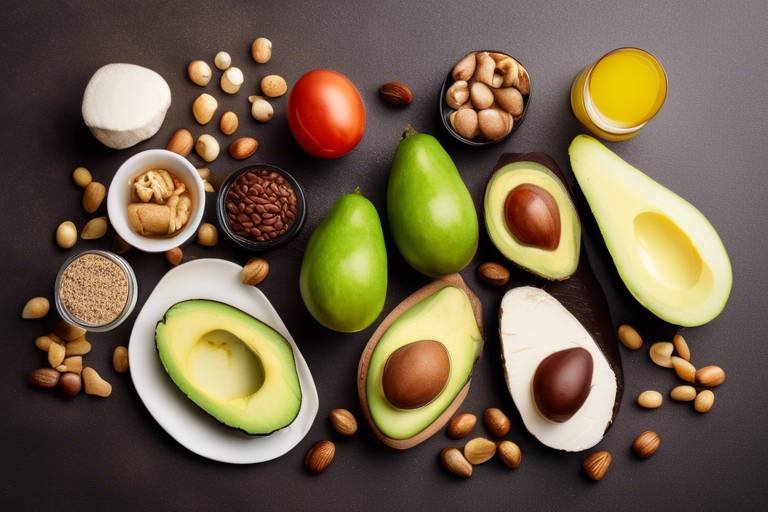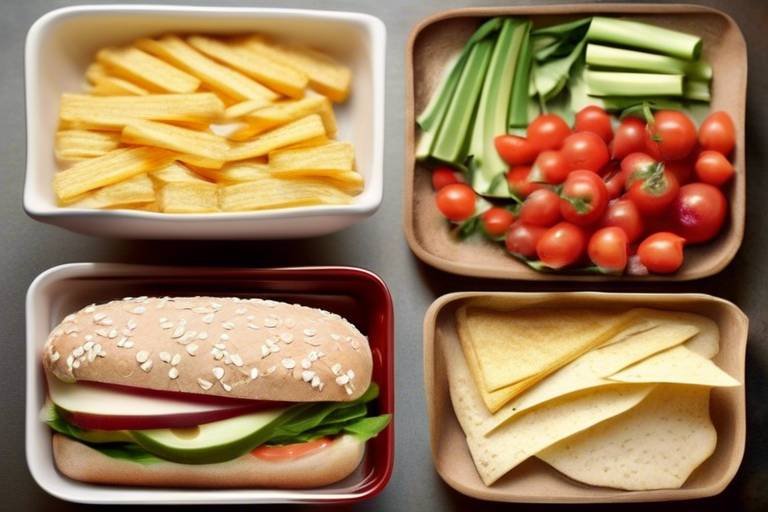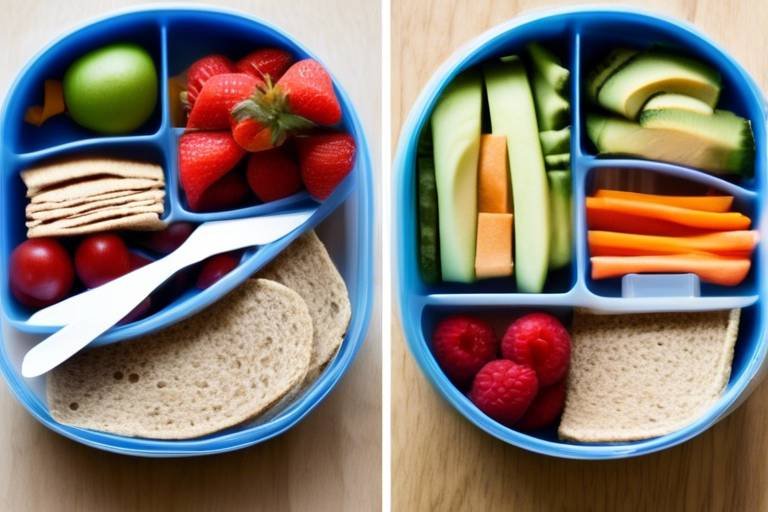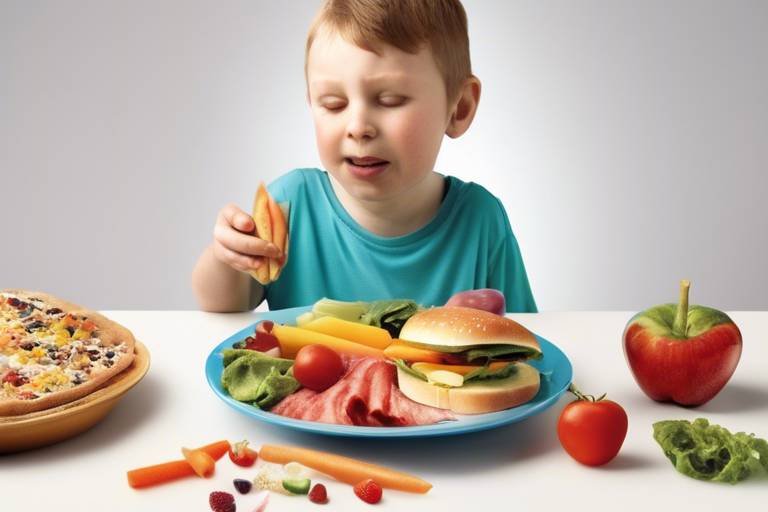How to Turn Your Kids into Veggie Lovers
Discovering how to turn your kids into veggie lovers can feel like a daunting task, but it doesn’t have to be! With a little creativity and some strategic approaches, you can transform your child's relationship with vegetables from one of reluctance to enthusiasm. Imagine your little ones actually asking for broccoli instead of pushing it away! It’s not just a dream; it’s entirely possible with the right mindset and methods. In this article, we will explore practical strategies that not only make vegetables more appealing but also create healthy eating habits that last a lifetime. Let's dive into the world of veggies and find out how to make them irresistible for kids!
First, let’s tackle the elephant in the room: picky eating. It’s a common phase for many children, often rooted in their developmental stages. Kids are naturally curious, but they can also be cautious, especially when it comes to trying new foods. This can lead to a strong aversion to vegetables, which are often unfamiliar and sometimes unappealing in appearance or texture. Understanding this behavior is crucial. Rather than forcing them to eat their greens, consider it a journey of exploration. Encourage them to touch, smell, and even play with vegetables before they try them. This way, you’re not just introducing them to new foods; you’re helping them build a positive association with veggies!
Next up, let’s talk about cooking techniques. The way you prepare vegetables can make a world of difference. Ever tried roasting carrots with a drizzle of honey? Or grilling zucchini until it’s perfectly charred? These methods can bring out natural sweetness and flavors that kids will love. Here are a few creative cooking techniques to consider:
- Roasting: Enhances sweetness and gives a crispy texture.
- Grilling: Adds a smoky flavor that many kids enjoy.
- Blending: Incorporate veggies into smoothies for a fun, nutritious drink.
- Hiding: Mix finely chopped vegetables into sauces or baked goods.
Experimenting with these techniques can make veggies not just edible but downright delicious!
One of the best ways to spark interest in vegetables is to involve your children in meal preparation. Kids love to feel like they are part of the action, and when they help prepare a meal, they are more likely to eat what they’ve made. Take them grocery shopping; let them pick out a new vegetable to try. At home, assign them simple tasks, like washing veggies or stirring a pot. This ownership can foster a sense of pride and curiosity about their food. Plus, it’s a fantastic opportunity to teach them about nutrition and the importance of healthy eating habits!
Have you ever thought about starting a small garden with your kids? Gardening can be an incredibly rewarding family activity. Not only does it teach children where their food comes from, but it also increases their willingness to eat the vegetables they’ve nurtured. Imagine the excitement on their faces when they harvest their first tomato or carrot! You don’t need a big backyard; even a few pots on a balcony can do the trick. Gardening together can be a fun way to bond while instilling a love for fresh produce.
Let’s face it: kids are drawn to fun! So why not make vegetables exciting? You can create colorful presentations on their plates, use cookie cutters to make fun shapes, or even theme meals around their favorite characters or stories. For instance, a “Dinosaur Dinner” could feature broccoli trees and carrot sticks as dino tails! The more engaging the meal, the more likely they will be to eat their veggies. Remember, the goal is to make eating vegetables an enjoyable experience, not a chore.
As parents, we are the ultimate role models for our children. If they see you enjoying a variety of vegetables, they are more likely to follow suit. Share your love for veggies by incorporating them into your meals and talking about their benefits. When kids see their parents making healthy choices, it reinforces the idea that eating vegetables is a normal and enjoyable part of life. So, let’s lead by example and show them how tasty and satisfying veggies can be!
Positive reinforcement can work wonders when it comes to encouraging kids to try new foods. Celebrate small victories, like tasting a new vegetable, with praise or a fun sticker chart. You can also set up a reward system where trying a certain number of new veggies earns them a fun outing or a special treat. This approach not only encourages them to try new things but also instills a sense of accomplishment. Remember, the goal is to make trying vegetables a fun and rewarding experience!
Lastly, let’s talk about presentation. Creating visually appealing and balanced meals can be a game-changer in getting kids to appreciate vegetables. Aim to fill their plates with a rainbow of colors. Not only is it more inviting, but it also ensures they’re getting a variety of nutrients. A well-balanced plate could include:
| Color | Vegetable | Benefit |
|---|---|---|
| Green | Spinach | Rich in iron |
| Orange | Carrots | High in beta-carotene |
| Red | Tomatoes | Full of antioxidants |
By making meals colorful and balanced, you’re not just feeding their bodies; you’re also feeding their minds with the idea that vegetables are a vital and enjoyable part of life!
Q: What if my child refuses to eat vegetables?
A: It’s common for kids to be hesitant. Keep offering them in different ways without pressure. Sometimes, it takes multiple exposures before they’ll try something new.
Q: How can I make vegetables more appealing?
A: Experiment with different cooking methods, presentations, and flavors. Making veggies fun and engaging can spark interest!
Q: Is it okay to hide vegetables in meals?
A: Yes! Hiding vegetables in sauces or baked goods can be a great way to ensure they’re getting the nutrients they need while they build a taste for them.
Q: What are some good vegetables to start with?
A: Start with sweeter vegetables like carrots, bell peppers, or peas. These are often more appealing to kids and can help ease them into trying more varieties.

Understanding Picky Eaters
When it comes to kids and their eating habits, the term picky eater often pops up, and it can be a real challenge for parents. But what exactly is behind this behavior? Understanding the psychology of picky eating is crucial for developing effective strategies to encourage your little ones to embrace vegetables. Kids may reject certain foods for various reasons, including texture, color, and even smell. Imagine a child looking at a plate of broccoli and thinking it resembles a tiny tree—suddenly, that plate is less appealing!
Research suggests that children are naturally inclined to be wary of new foods, a survival mechanism inherited from our ancestors. This instinct helped them avoid potentially harmful substances. However, in today’s world, this wariness can hinder their willingness to try nutritious options like vegetables. The key is to understand that this behavior is not a personal affront to your cooking skills; it’s a natural part of their development.
To tackle this issue, it’s essential to create a positive and non-pressuring environment around mealtime. Here are some insights into why kids might be picky and how you can help:
- Texture Sensitivity: Some children are particularly sensitive to textures, which can make certain vegetables unappealing. For instance, the crunchiness of raw carrots might be off-putting, while the softness of cooked carrots could be more acceptable.
- Fear of the Unknown: Kids often fear what they don’t know. If they haven’t been exposed to a variety of vegetables, they may shy away from trying them. This is where gradual exposure comes into play!
- Peer Influence: Children observe their peers and may adopt similar eating habits. If their friends are avoiding veggies, your child might too. This is why setting a good example is crucial.
Understanding these factors can help you approach the situation with empathy. Instead of pushing vegetables onto their plates, consider introducing them in a fun and engaging way. For example, try incorporating veggies into dishes they already love or presenting them in a colorful, playful manner. Remember, it’s all about making the experience enjoyable rather than a chore.
In conclusion, tackling picky eating requires patience, creativity, and understanding. By recognizing the underlying reasons for their reluctance and addressing them thoughtfully, you can help your kids develop a more adventurous palate. Who knows? With a little time and effort, those tiny tree-like broccoli florets might just become their new favorite snack!

Creative Cooking Techniques
When it comes to getting your kids to embrace vegetables, can make all the difference. If you think about it, the way food is prepared can either entice or repel young eaters. Imagine presenting a plate of steamed broccoli versus a vibrant stir-fry with colorful peppers and a hint of garlic. Which one do you think would spark more interest? By using various cooking methods, you can transform ordinary vegetables into exciting and delicious dishes that your kids will actually want to eat.
One fantastic technique is roasting. This method not only enhances the natural sweetness of vegetables but also adds a delightful crunch. Toss some carrots, zucchini, and bell peppers in olive oil, sprinkle with a bit of salt and pepper, and roast them in the oven until they're golden brown. The result? A colorful medley that looks as good as it tastes! Kids are often more willing to try roasted veggies because the flavor is intensified, making them more appealing.
Another engaging way to prepare vegetables is through grilling. Grilled veggies have a smoky flavor that can be irresistible. Try skewering cherry tomatoes, mushrooms, and chunks of bell pepper, then let your kids help brush them with a marinade. Not only does grilling make the veggies taste amazing, but it also turns the cooking process into a fun family activity. Plus, who doesn’t love food on a stick? It’s like a party on a plate!
Incorporating vegetables into familiar dishes is also a clever trick. Think about adding shredded carrots or spinach into spaghetti sauce, or blending cauliflower into mashed potatoes. These sneaky additions boost the nutritional value without altering the taste significantly. Kids often won’t even notice they’re eating vegetables, which is a win-win for parents!
Here’s a quick table to illustrate some creative cooking techniques and their benefits:
| Cooking Technique | Benefits |
|---|---|
| Roasting | Enhances sweetness and adds crunch |
| Grilling | Adds smoky flavor and makes food fun |
| Sautéing | Quick cooking preserves nutrients and flavor |
| Blending | Incorporates veggies into favorite dishes unnoticed |
Don’t forget about presentation! Kids are visual eaters, so making vegetables look fun can entice them to dig in. Use cookie cutters to create fun shapes, or arrange veggies into a colorful rainbow on their plates. You can even create themed meals, like a “Taco Night” with lots of toppings, including guacamole, shredded lettuce, and diced tomatoes. The more engaging the meal, the more likely they are to take that first bite!
In conclusion, using creative cooking techniques is an effective way to make vegetables more appealing to kids. By roasting, grilling, and presenting them in fun ways, you can encourage your little ones to embrace these nutritious foods. Remember, it’s all about making the experience enjoyable and flavorful—because who said healthy eating can’t be fun?

Involving Kids in Meal Prep
When it comes to getting kids to eat their veggies, one of the most effective strategies is to involve them in meal preparation. Think about it: when children have a hand in creating their meals, they're more likely to feel a sense of ownership and excitement about what they’re eating. Imagine your child proudly declaring, "I made this!" as they munch on a colorful veggie stir-fry they helped prepare. The kitchen can transform into a playground of flavors and textures, making the experience both educational and enjoyable.
Start with simple tasks that are age-appropriate. Younger children can wash vegetables, while older kids can help chop (under supervision, of course!). You could say, “Let’s make our own pizza tonight! You can choose which veggies to add!” This not only gives them some control but also allows them to experiment with different flavors. Plus, it’s a fantastic opportunity to teach them about nutrition and the benefits of each vegetable. For instance, you might explain how carrots are great for their eyesight or how spinach can help them grow strong.
Additionally, consider setting up a weekly meal prep day where the whole family can participate. This could be a fun bonding time, where everyone contributes to planning the menu. You can create a colorful chart that lists the veggies available for the week, allowing kids to pick their favorites. This way, they feel more invested in the meals they’ll be eating throughout the week.
| Age Group | Meal Prep Tasks |
|---|---|
| 3-5 years | Washing vegetables, tearing lettuce, stirring ingredients |
| 6-8 years | Peeling, measuring ingredients, assembling dishes |
| 9-12 years | Chopping (with supervision), cooking simple recipes, planning meals |
Another great way to engage your kids is by introducing themed meal nights. For example, you could have a taco night where everyone gets to choose their toppings, including a variety of vegetables. This not only makes the meal fun but also encourages them to try new things. You could even create a “veggie challenge,” where each family member brings a new vegetable to try each week, turning it into a mini-adventure!
Lastly, don’t forget the power of storytelling. Share stories about how you used to help in the kitchen when you were their age, or tell them about the origins of certain dishes. This can spark their curiosity and make them more eager to participate. Remember, involving kids in meal prep is not just about getting them to eat veggies; it’s about creating lasting memories and teaching them valuable life skills. So roll up your sleeves, put on some aprons, and get ready for some fun in the kitchen!
Q: How can I make meal prep fun for my kids?
A: Turn it into a game! Create themed nights, let them choose ingredients, or set up a cooking competition.
Q: What if my child refuses to eat the veggies they helped prepare?
A: That’s perfectly normal! Keep offering them without pressure, and encourage them to try just a bite. Taste preferences can change over time.
Q: Are there any specific tasks I should avoid for younger kids?
A: Yes, avoid tasks that involve sharp knives or hot surfaces. Always supervise them closely during meal prep.

Gardening Together
Gardening together as a family is not just an enjoyable pastime; it’s a fantastic way to introduce your kids to the world of vegetables in a hands-on manner. Imagine the thrill on their faces as they dig their hands into the soil, planting seeds that will eventually sprout into the very veggies they may have previously turned their noses up at. When children are involved in the entire process—from planting to watering and finally harvesting—they develop a deeper appreciation for what they eat. This connection can transform their perception of vegetables from something they have to eat into something they have helped create.
Moreover, gardening teaches kids about responsibility and patience. It’s a lesson in nurturing and understanding that good things take time. As they water their plants and watch them grow, they learn that vegetables don’t just appear magically on their plates. This awareness can spark curiosity and encourage them to try the vegetables they’ve grown. In fact, studies have shown that children who participate in gardening are more likely to consume a variety of fruits and vegetables.
When you start your gardening journey, consider these key points to make it enjoyable and educational:
- Choose Easy-to-Grow Vegetables: Start with vegetables that are simple to cultivate, such as carrots, radishes, or cherry tomatoes. These quick-growing plants can provide instant gratification and keep your kids engaged.
- Incorporate Fun Tools: Let your kids use colorful gardening tools. Child-sized spades, watering cans, and gloves can make the experience more enjoyable and give them a sense of ownership.
- Make it a Family Event: Dedicate a specific day of the week for gardening. This routine can become a cherished family tradition, fostering teamwork and communication.
Additionally, you can turn gardening into a learning opportunity. Teach your kids about the different types of vegetables, their nutritional benefits, and the importance of eating a rainbow of colors. You might even create a chart to track what you’ve planted and when it will be ready to harvest. This can serve as a fun educational tool that keeps them excited about the process.
As the harvest season approaches, involve your kids in the preparations for cooking their home-grown vegetables. Whether it’s a simple salad or a more elaborate dish, cooking together can reinforce the idea that eating veggies can be both fun and delicious. You can even have a small family cook-off where each member creates a dish using the vegetables they’ve grown, adding a competitive yet light-hearted spirit to the experience.
In essence, gardening together not only promotes healthy eating habits but also strengthens family bonds. It’s about creating memories while cultivating a love for vegetables that can last a lifetime. So grab your gardening gloves, and get ready to dig in—literally!
Q: What age is appropriate to start gardening with my kids?
A: You can start gardening with kids as young as 2 or 3 years old. Just ensure that the tasks are age-appropriate and safe.
Q: How do I keep my kids engaged in gardening?
A: Keep it fun! Use colorful tools, let them choose what to plant, and make it a family event. Celebrate small successes to keep their interest alive.
Q: What are some easy vegetables for beginners?
A: Some easy vegetables to start with include radishes, lettuce, carrots, and cherry tomatoes. They grow quickly and are usually well-received by children.
Q: How can I make gardening educational?
A: Incorporate lessons about plant biology, nutrition, and the environment. Use charts or journals to track growth and changes, turning gardening into a comprehensive learning experience.

Making Vegetables Fun
When it comes to getting kids excited about vegetables, creativity is your best friend! Imagine turning a simple broccoli floret into a tiny tree or transforming carrot sticks into colorful "magic wands." By making vegetables visually appealing and engaging, you can spark your child's curiosity and encourage them to dive into their greens with enthusiasm. It's all about presentation!
One effective way to make vegetables fun is by incorporating them into themed meals. For instance, you could host a Rainbow Dinner, where each dish features a different color vegetable. Think red bell peppers, orange carrots, yellow corn, green peas, and purple cabbage. Not only does this create a vibrant plate, but it also introduces children to a variety of flavors and textures. You can even have a little fun by asking your kids to guess the colors of the veggies before they taste them!
Another fantastic method is to use cookie cutters to shape vegetables into fun designs. You can create stars, hearts, or even animal shapes with cucumbers, bell peppers, and zucchini. This playful approach makes eating veggies feel like a game rather than a chore. You might find that your child is more willing to munch on a star-shaped cucumber than a regular slice!
To further enhance the fun factor, consider creating a Veggie Art Station during meal prep. Lay out a variety of chopped vegetables and let your kids create their own edible masterpieces. This hands-on activity not only promotes creativity but also allows them to take ownership of their food. Plus, when they see their artwork on the dinner table, they might feel more inclined to taste the very creations they made!
Don't forget about the power of dips! Kids love to dip their food, and pairing veggies with tasty dips can make all the difference. Try hummus, yogurt-based ranch, or even a simple guacamole. Set up a Veggie Dip Bar at mealtime where kids can choose their favorite veggies and dips. This not only makes eating more interactive but also encourages them to try different combinations, making the experience exciting.
Lastly, storytelling can be a magical tool to make vegetables more appealing. Create fun stories around each vegetable, like how carrots help you see in the dark or how spinach gives you super strength. By weaving narratives into mealtime, you can capture your child's imagination and make them more eager to try what's on their plate. After all, who wouldn't want to eat a "superhero" food?
In conclusion, making vegetables fun is all about creativity, engagement, and a little bit of magic. By presenting veggies in exciting ways, involving your kids in the preparation, and using storytelling, you can transform the perception of vegetables from boring to adventurous. So, roll up your sleeves, grab those veggies, and let the fun begin!
- How can I get my child to try new vegetables? Start by introducing new veggies alongside their favorites and encourage them to taste just one bite.
- What are some easy recipes to make vegetables more appealing? Try roasting vegetables with a sprinkle of cheese or blending them into smoothies for a delicious treat.
- Is it okay to use dips with vegetables? Absolutely! Dips can make veggies more enjoyable and encourage kids to eat more of them.
- How often should I introduce new vegetables to my child? Aim to introduce at least one new vegetable each week to keep things fresh and exciting.

Setting a Good Example
When it comes to nurturing healthy eating habits in children, one of the most powerful tools at your disposal is modeling behavior. Kids are like little sponges, soaking up everything they see and hear. If they witness their parents and caregivers enjoying a variety of vegetables, they are more likely to follow suit. It’s all about creating an environment where healthy eating is the norm rather than the exception. Have you ever noticed how children tend to mimic adult behavior? This can be both a blessing and a challenge, especially when it comes to food choices.
Consider this: if you’re sitting at the dinner table, happily munching on a vibrant salad or sautéed broccoli, your child is more likely to be curious about those foods. On the flip side, if you’re grimacing at the sight of greens or pushing them aside, your child will likely adopt a similar attitude. It’s essential to be conscious of the messages you send through your own eating habits.
To effectively set a good example, you might want to incorporate the following strategies:
- Be adventurous: Try new vegetables and prepare them in different ways. Share your excitement with your kids when you discover a new favorite!
- Make it a family affair: Enjoy meals together as a family. This not only strengthens bonds but also reinforces the idea that eating healthy is a family value.
- Discuss your choices: Talk about why you love certain vegetables. Maybe you enjoy how crunchy carrots can be, or how vibrant bell peppers add color to your plate. Sharing your thoughts can pique their interest.
Additionally, it’s crucial to maintain a positive attitude towards food. Instead of labeling vegetables as “good” and junk food as “bad,” aim for a more balanced view. Emphasize the benefits of eating vegetables, such as improved energy and better digestion, rather than focusing on restrictions. This approach not only makes vegetables seem less intimidating but also helps cultivate a healthy relationship with food.
Another important aspect is consistency. Kids thrive on routine, and having regular family meals where vegetables are featured prominently can help reinforce their importance. Over time, as your children see you consistently enjoying vegetables, they may begin to associate them with positive experiences, making them more likely to try them.
Ultimately, remember that setting a good example is not just about what you eat, but also about how you talk about food. Foster an atmosphere of curiosity and exploration when it comes to vegetables. Encourage your children to ask questions about different foods and their health benefits, and celebrate their efforts to try new things, no matter how small. By doing so, you’re not just teaching them to eat their veggies; you’re instilling lifelong habits that will benefit them for years to come.
Q: What if my child refuses to eat vegetables?
A: It's common for children to be hesitant about trying new foods. Keep offering a variety of vegetables without pressure, and consider involving them in meal prep to spark their interest.
Q: How can I make vegetables more appealing?
A: Experiment with different cooking methods, such as roasting or grilling, and present them in fun shapes or colorful arrangements to make them visually appealing.
Q: What role does my attitude towards food play?
A: Your attitude significantly influences your child's perception of food. Maintaining a positive outlook and being enthusiastic about vegetables can encourage them to be more open to trying them.

Positive Reinforcement Techniques
When it comes to encouraging kids to embrace vegetables, positive reinforcement can be a game-changer. Think about it: just like a puppy learns tricks for treats, children can be motivated to try new foods through praise and rewards. It’s about creating a positive association with veggies, so they don’t see them as a chore but rather as a delightful part of their meals. Imagine your child taking a bite of broccoli and you responding with enthusiastic applause—this simple act can boost their confidence and make them more willing to try it again!
One effective strategy is to offer verbal praise every time your child tries a new vegetable. Instead of just saying "good job," try to be specific. For instance, you might say, "Wow, you really chewed that carrot well! I love how brave you are!" This kind of feedback not only makes them feel good about their choices but also encourages them to keep experimenting with different veggies. Additionally, consider implementing a reward system where trying a new vegetable earns them points towards a fun activity or a small treat. This can be as simple as a sticker chart where they earn a sticker for each new veggie they try.
Another way to reinforce positive behavior is to create a family veggie night. This can be a weekly event where everyone tastes a new vegetable together. Kids love being part of the family dynamic, and this can turn trying new foods into a fun, shared experience. You can even spice things up by letting them choose the veggie of the week, giving them a sense of ownership over their food choices. When they feel involved, they’re more likely to be excited about eating what they’ve helped select!
Moreover, it’s crucial to remember that patience is key. Not every child will take to vegetables right away, and that’s perfectly normal. Instead of pushing them too hard, celebrate small victories. If they nibble on a piece of cucumber, throw a mini celebration! This shows them that every little step counts. Over time, with consistent positive reinforcement, they’ll likely develop a more adventurous palate.
Lastly, it’s important to model the behavior you want to see. If your kids see you enjoying a variety of vegetables, they’re more likely to follow suit. Make it a family affair by sitting down together and sharing your experiences with different veggies. Talk about the flavors, textures, and how they make you feel. Kids are observant; they’ll pick up on your enthusiasm and may just want to join in on the veggie love!
- How can I encourage my child to try new vegetables?
Start with positive reinforcement, praise them for trying new foods, and involve them in meal preparation.
- What if my child refuses to eat vegetables?
Be patient and continue to offer a variety of vegetables without pressure. Try different cooking methods to make them more appealing.
- Are there any fun ways to present vegetables?
Absolutely! Try cutting veggies into fun shapes or arranging them into colorful patterns on the plate.

Creating a Balanced Plate
When it comes to encouraging kids to embrace vegetables, the concept of a balanced plate plays a pivotal role. Picture this: a plate that not only looks appealing but also provides a rainbow of nutrients essential for your child's growth and development. It’s like painting a masterpiece where every color represents a different food group. But how do we achieve this culinary canvas? Let’s dive in!
First off, a balanced plate should consist of a variety of food groups. Aim for a mix of fruits, vegetables, grains, and proteins. This not only ensures that your kids are getting the nutrients they need but also keeps their taste buds engaged. For instance, try to fill half of the plate with colorful veggies and fruits. Not only does this add visual appeal, but it also introduces a range of flavors that can excite young eaters. Think of it as a garden party on their plate!
To make it even easier, consider using the MyPlate model as a guide. This visual representation divides the plate into sections, offering a clear idea of how much of each food group to include. Here’s a simple breakdown:
| Food Group | Recommended Portion |
|---|---|
| Vegetables | 50% |
| Fruits | 25% |
| Grains | 25% |
| Protein | Varies |
Now, let’s talk about the fun part: presentation! Kids are naturally drawn to bright colors and fun shapes. Try cutting vegetables into fun shapes using cookie cutters or arranging them in a way that tells a story. For example, you could create a “veggie rainbow” on their plate or make a smiley face with their favorite ingredients. This not only makes the meal visually appealing but also encourages them to explore new tastes.
In addition to presentation, consider the textures and flavors you combine. Mixing crunchy carrots with creamy hummus or pairing sweet bell peppers with zesty dips can create a delightful experience. It's all about making the veggies the star of the show! By creating a balanced plate that is both nutritious and exciting, you’re setting the stage for your children to appreciate the goodness of vegetables.
Lastly, don’t forget to involve your kids in the process! Let them help choose the vegetables at the grocery store or assist in arranging the plate at home. When they take part in creating their meals, they’re more likely to feel ownership over their food choices and will be eager to dig in. Remember, the journey to becoming veggie lovers starts with a balanced plate that is as fun to eat as it is healthy!
- How can I encourage my kids to try new vegetables? Involve them in meal prep, make veggies fun, and offer a variety of options.
- What are some good vegetables for picky eaters? Start with milder flavors like carrots, cucumbers, and sweet bell peppers.
- How can I make vegetables more appealing? Use creative presentation, pair them with dips, and incorporate them into favorite dishes.
Frequently Asked Questions
- What are some effective strategies to encourage kids to eat more vegetables?
One of the best strategies is to involve them in the cooking process. When kids help prepare meals, they are more likely to try what they’ve made. Additionally, presenting vegetables in fun and creative ways can make them more appealing. Think colorful plates, fun shapes, or even themed meals that spark their imagination!
- How can I get my picky eater to try new vegetables?
Start by introducing new veggies gradually and pair them with familiar foods. Positive reinforcement plays a huge role here—praise them when they try something new! You might also consider a reward system, where they earn small rewards for trying new vegetables. Remember, patience is key; it may take several attempts before they accept a new flavor.
- Does gardening really help kids eat more vegetables?
Absolutely! Gardening is a fantastic way to teach kids about where their food comes from. When children see the entire process—from planting seeds to harvesting veggies—they often develop a greater appreciation for them. Plus, they’re more likely to eat what they’ve grown themselves!
- What cooking techniques make vegetables more appealing to kids?
Cooking techniques like roasting or grilling can enhance the natural sweetness of vegetables, making them tastier. You can also blend vegetables into sauces or soups, which can disguise their presence while still providing nutrients. Experimenting with different spices and herbs can also add flavor and excitement!
- How important is parental influence in shaping a child’s eating habits?
Parental influence is crucial! Kids often mimic the eating habits of their parents. If they see you enjoying a variety of vegetables, they’re more likely to follow suit. Make it a family affair by sharing meals together and discussing the benefits of healthy eating. Your enthusiasm can be contagious!
- What are some fun ways to present vegetables to kids?
Get creative! Use cookie cutters to make fun shapes or arrange veggies into colorful patterns on their plates. You can also create themed meals, like “rainbow night,” where you serve a variety of colorful vegetables. Making it visually appealing can spark their interest and make mealtime more enjoyable.
- How can I create a balanced plate that includes vegetables?
Start by filling half the plate with a variety of vegetables. Aim for different colors and textures to make it visually appealing. Incorporate a protein source and a whole grain to complete the meal. Teaching kids about balance and presentation will help them appreciate the importance of including veggies in their diet.
- What role does positive reinforcement play in encouraging kids to eat vegetables?
Positive reinforcement is incredibly effective! When you celebrate their efforts to try new vegetables, it builds their confidence and encourages them to keep experimenting. Simple praise, stickers, or small rewards can go a long way in making them feel good about their choices.



















